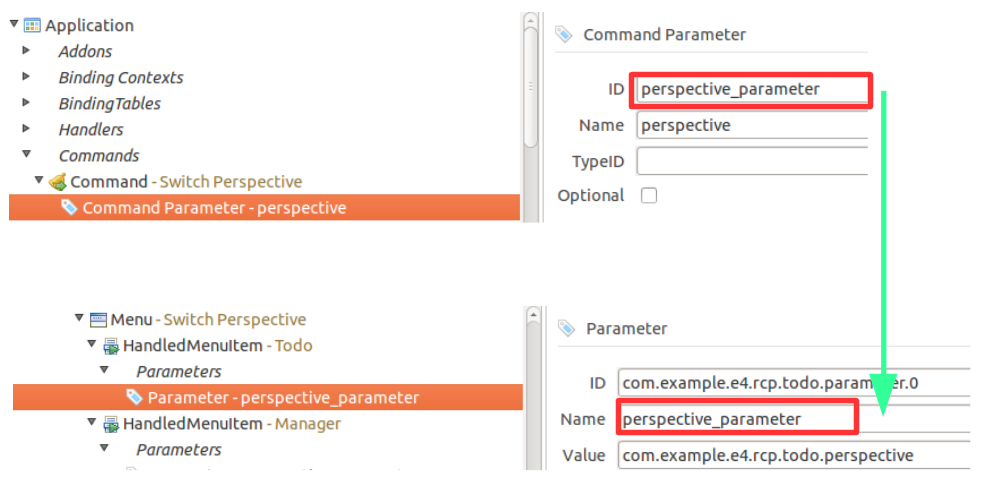- Eclipse4 RCP 指南
- 介绍
- 1. 什么是 Eclipse RCP 应用程序?
- 2. Eclipse 体系
- 3. 下载 Eclipse 软件开发包(SDK)
- 4. 练习:创建 RCP 应用程序向导
- 5. 使用运行配置
- 6. 启动配置及 Eclipse 产品
- 7. 常见的启动问题
- 8. Eclipse 4 应用程序模型
- 9. 用户接口模型元素
- 10. 连接模型元素到类和资源
- 11. 模型对象以及运行时应用程序模型
- 12. 特征及产品
- 13. 练习:建立一个插件
- 14. 练习:转换插件为 Eclipse 4 应用程序
- 15. 练习:删除持久化模型数据
- 16. 练习:用户接口建模
- 17. 练习:连接 Part 和 Java 类
- 18. 输入依赖
- 19. 练习:用 Swt 浏览器插件
- 20. 依赖注入介绍
- 21. 依赖注入与注解
- 22. Eclipse 上下文
- 23. 对依赖注入有效的对象
- 24. 用 Annotation 定义行为
- 25. 练习:用 @PostConstruct
- 26. 菜单以及工具条应用程序对象
- 27. Handler 类的依赖注入
- 28. @CanExecute 的执行
- 29. 练习:添加菜单
- 30. 练习:添加一个工具栏
- 31. 视图、弹出以及动态菜单
- 32. 工具栏、工具控制以及下拉工具项
- 33. 更多关于 commands 和 handlers
- 34. 核心表达式用法
- 35. Key 绑定
- 36. 通过右键启动产品
- 37. 关于中文翻译
更多关于 commands 和 handlers
传递参数到 commands
你也可以传递参数到 commands,选择一个 command,然后在参数下点击[添加]按钮。
ID 是你用来获取通过@Named注解注入的参数值的标识,

在你的 HandledMenuItem 或 HandledToolItem 中,添加一个参数,然后将来自 Name 字段定义的 command 参数放进去。Value 字段传递给 command 的 handler。

警告,参数的 ID 是重要的,ID 必须通过 @Named 注解来注入,并且在定义菜单或工具条时用作 Name(第二个字段)。这在下面的图中高亮显示:
为了得到注入到你的 handler 类中的参数,你通过 @Named 注解指定参数的 ID,这通过下面的代码演示:
package com.example.e4.rcp.todo.handlers;
import java.util.List;
import javax.inject.Named;
import org.eclipse.e4.core.di.annotations.Execute;
import org.eclipse.e4.ui.model.application.MApplication;
import org.eclipse.e4.ui.model.application.ui.advanced.MPerspective;
import org.eclipse.e4.ui.model.application.ui.basic.MWindow;
import org.eclipse.e4.ui.workbench.modeling.EModelService;
import org.eclipse.e4.ui.workbench.modeling.EPartService;
// switcher perspectives based on a command parameter
public class PerspectiveSwitchHandler {
@Execute
public void switchPerspective(MWindow window,
EPartService partService,
EModelService modelService,
@Named("perspective_parameter") String perspectiveId) {
// use parameter to find perspectives
List<MPerspective> perspectives = modelService.findElements(window,
perspectiveId, MPerspective.class, null);
// switch to perspective with the ID if found
if (!perspectives.isEmpty()) {
partService.switchPerspective(perspectives.get(0));
}
}
}
提示:除了注入每个参数,你也可以注入 ParameterizedCommand command,然后通过 API 来访问参数。
package com.example.e4.rcp.todo.handlers;
import javax.inject.Named;
import org.eclipse.e4.core.di.annotations.Execute;
public class TestHandlerWithCommandInjected {
private String parametername = "com.example.e4.rcp.todo" +
".commandparameter.input";
@Execute
public void execute(ParameterizedCommand command) {
Object queryId = command.getParameterMap().get(parametername);
// more...
}
}
